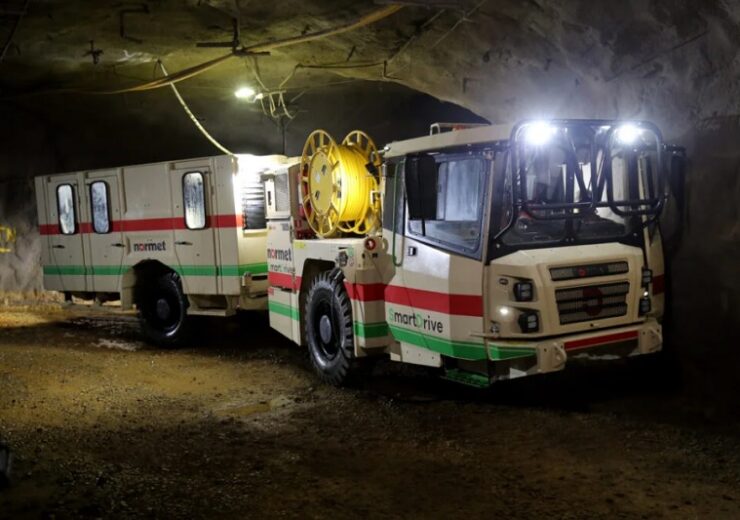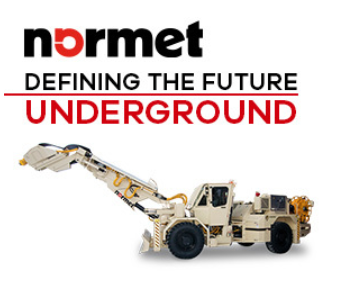Clean energy requires the consumption of sustainable minerals. Although the climate crisis has sparked the increased demand for renewables, the mining industry continues to be heavily influenced by the fossil-fuel industry. Net zero is a must-have holistic approach to efficiency enhancements that are backed with an understanding of the "kaizen" ethos of continuous improvements in increments, driven by the latest technological innovations.

Normet’s Utimec MF 205 PER SD in action in the Pyhasalmi mine - 2021. (Credit: Normet)
As the planet is nearing a collapse into a massive climate crisis, the call for sustainable development takes on a more dire tone. Recent research has exposed the dangers of failing to end our dependence on fossil fuels, which adds to the dire warnings in the most recent report released by the Intergovernmental Panel on Climate Change (IPCC).
IPCC Working Group III Co-Chair Jim Skea said that limiting global warming to 1.5°C (2.7°F) is not possible unless immediate and deep emissions reductions are seen across all sectors.
Minerals for energy transition
A key element in ensuring green power and clean transportation is believed to be widespread electrification. Mining is already shifting to satisfy a massive growth in demand for important energy transition minerals.
Cobalt, lithium, and graphite mining have seen a solid increase in the last few years, according to an analysis of data by Mining Technology from GlobalData’s commodity analyser database.
An IEA report explains why these minerals are becoming increasingly crucial for battery technology as well as renewable energy networks. In addition to the obvious importance of lithium-ion batteries that are fuelling the market, solar panels need crystallised silicon made from quartz and varying quantities of copper based on the application. For instance, according to IEA, “distributed solar PV systems” call for about 40% more copper compared to utility scale projects.
Copper is also considered to be one of the “two main materials in wires and cables” and is believed to be vital, in addition to alternatives like aluminium, to facilitate a “huge expansion of electricity grids”.
Reducing dependence on fossil fuels and lowering emissions
But as global mining operations extracting essential commodities increase in both size and number, every stakeholder is confronted by the twin challenges of reducing dependence on fossil fuels as well as lowering the emissions resulting from mining and processing.
An analysis conducted by Mining Technology on GlobalData’s data for mining emissions indicates that, despite the increase in electrification in the mining sector, it is still dependent upon fossil fuels. The majority of the power consumed since 2016 is still derived from non-renewable sources.
Reliance on fossil fuels increases the carbon footprint of mining companies which means that any substantial reduction in emissions is difficult. Analysis reveals how the situation is changing, and not for the better, as the consumption of non-renewable fossil fuels has been growing since 2016.
Mining operations continue to be plagued by the emissions of scope 3, which are defined by the Carbon Trust as emissions that indirectly “occur in a company’s value chain”. This suggests that radical reforms are required to make the industry truly sustainable.
According to a paper published from the Transition Pathway Initiative, downstream processing and the sale of commodities such as iron ore, copper, bauxite, as well as “hydrocarbon-based energy products (like coal, crude oil, and natural gas)” are significant elements in the mining industry’s impacts on the climate. The analysis demonstrates how the emissions in the scope 3 category represent significant proportions of the total issue.
The analysis by Mining Technology also shows that the emissions from scope 3 have significantly increased over the last five years and are higher than either scope 1 or 2, despite a recent pandemic decline. If this pattern continues to grow in the coming years, the mining industry will be unable to cut down its carbon emissions between now and 2030. This means that it will be difficult to reach the emissions levels that the IPCC claim are needed to “secure a liveable future”.
Enhancing approach to sustainability
Mining Technology spoke with Normet Group senior vice president Riku Helander and Mark Ryan, the company’s equipment offering and new technology vice president, about how they are making use of different parts of their portfolio and ethos to assist mining companies enhance their approach to sustainability.
Ryan said: “We…adopt ‘Kaizen’ (change for the better) in trying to reduce waste…the whole idea of continuous improvement is the backbone of what we do.”
Helander described the interconnected elements that work together to ensure that sustainable mining is reached. He highlighted that it is crucial to “minimising any environmental impact… including things like a minimum amount of waste” as well as “ensuring that the working environment is as safe as possible” in addition to “eliminating harmful emissions”. The latter aspect was also highlighted by Ryan who painted an image of how efficient waste management, along with removing the need for ventilation for mining could result in massive efficiency savings.
One of the top products of Normet that can revolutionise the underground mining ventilation is the SmartDrive modular battery electric vehicle (BEV) technology, that is “designed to optimise energy consumption and performance in underground mining and tunnelling applications”. The vehicles come with a broad array of distinct features that can lead to increased productivity, less operating costs, as well as “zero local emissions”.
For Ryan, the benefits of reducing emissions have many facets while having a major impact on the sustainability of mining.
Ryan said: “Massive amounts of energy are required to ventilate a mine, if you’re able to avoid the need to dilute diesel particulate matter (DPM), then you…reduce your ventilation requirements…and you reduce waste.
“Our customers have to put in a significant amount of additional infrastructure for ventilation [which] requires energy. [with SmartDrive] you are reducing costs and energy needs.”
Normet also has a range of products and services to offer which are related to enhancing the efficiency of sprayed concrete applications, which includes the SmartScan technology to allow users to “determine the exact thickness” required under various circumstances, thereby cutting down waste and energy needs.
Ryan said: “Going back to this continuous improvement or Kaizen approach. Another process we’re involved in is explosive charging…there are lots of areas where we can reduce waste. Ventilation is needed after the blasting process to flush away the explosive gases…with our technology we…activate the explosives far more efficiently.”
Harmonised regulations
Future solutions for climate crisis will need innovative technological solutions and the determination to alter the course. A recent study from the Institute for Advanced Sustainability Studies provided a comprehensive overview of ways the mining industry can take several strategies, such as harmonised regulations as “global governance structures”, to “offset some of its negative impacts”.
How IoT can help with sustainable mining
Another aspect is the way the Internet of Things (IoT) technology can help mines to become more efficient and environmentally sustainable.
Ryan discussed the reasons why this technology can change the landscape in the field. He said: “IoT or connectivity of machines is incredibly important…it takes the roof off the mine so [customers] can really understand and see what their assets are doing at any one time. It makes their operation more predictable and less reactive.”
Ryan explained that when you go back to Kaizen and if you have this data and that information you can use them to develop a fresh strategy to increase productivity and to cut waste, it’s a massive leap forward.
There isn’t a silver bullet that can solve the issue to make mining sustainable overnight. But stakeholders can implement an organised approach to make sure that the mining industry’s path moves slowly towards achieving true global sustainability.

